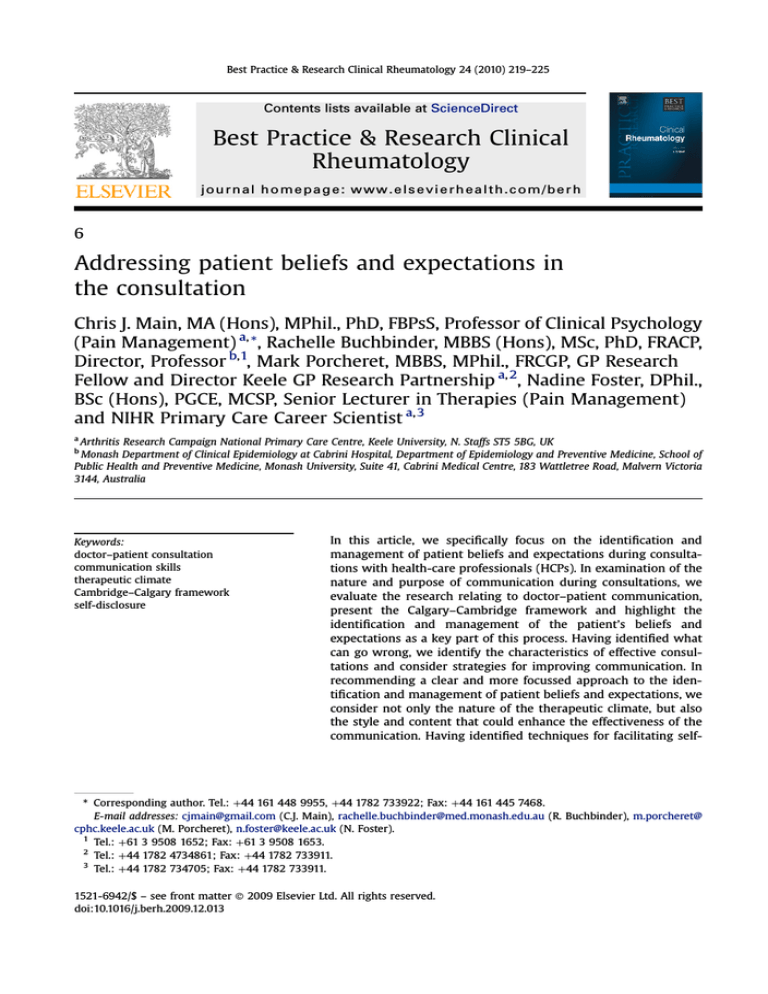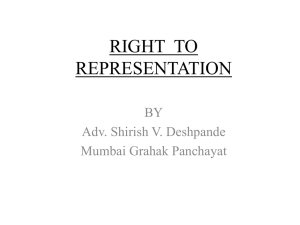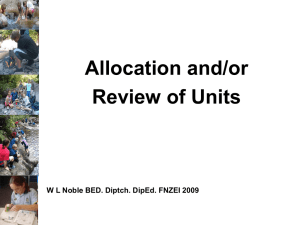
Best Practice & Research Clinical Rheumatology 24 (2010) 219–225
Contents lists available at ScienceDirect
Best Practice & Research Clinical
Rheumatology
journal homepage: www.elsevierhealth.com/berh
6
Addressing patient beliefs and expectations in
the consultation
Chris J. Main, MA (Hons), MPhil., PhD, FBPsS, Professor of Clinical Psychology
(Pain Management) a, *, Rachelle Buchbinder, MBBS (Hons), MSc, PhD, FRACP,
Director, Professor b,1, Mark Porcheret, MBBS, MPhil., FRCGP, GP Research
Fellow and Director Keele GP Research Partnership a, 2, Nadine Foster, DPhil.,
BSc (Hons), PGCE, MCSP, Senior Lecturer in Therapies (Pain Management)
and NIHR Primary Care Career Scientist a, 3
a
Arthritis Research Campaign National Primary Care Centre, Keele University, N. Staffs ST5 5BG, UK
Monash Department of Clinical Epidemiology at Cabrini Hospital, Department of Epidemiology and Preventive Medicine, School of
Public Health and Preventive Medicine, Monash University, Suite 41, Cabrini Medical Centre, 183 Wattletree Road, Malvern Victoria
3144, Australia
b
Keywords:
doctor–patient consultation
communication skills
therapeutic climate
Cambridge–Calgary framework
self-disclosure
In this article, we specifically focus on the identification and
management of patient beliefs and expectations during consultations with health-care professionals (HCPs). In examination of the
nature and purpose of communication during consultations, we
evaluate the research relating to doctor–patient communication,
present the Calgary–Cambridge framework and highlight the
identification and management of the patient’s beliefs and
expectations as a key part of this process. Having identified what
can go wrong, we identify the characteristics of effective consultations and consider strategies for improving communication. In
recommending a clear and more focussed approach to the identification and management of patient beliefs and expectations, we
consider not only the nature of the therapeutic climate, but also
the style and content that could enhance the effectiveness of the
communication. Having identified techniques for facilitating self-
* Corresponding author. Tel.: þ44 161 448 9955, þ44 1782 733922; Fax: þ44 161 445 7468.
E-mail addresses: cjmain@gmail.com (C.J. Main), rachelle.buchbinder@med.monash.edu.au (R. Buchbinder), m.porcheret@
cphc.keele.ac.uk (M. Porcheret), n.foster@keele.ac.uk (N. Foster).
1
Tel.: þ61 3 9508 1652; Fax: þ61 3 9508 1653.
2
Tel.: þ44 1782 4734861; Fax: þ44 1782 733911.
3
Tel.: þ44 1782 734705; Fax: þ44 1782 733911.
1521-6942/$ – see front matter ! 2009 Elsevier Ltd. All rights reserved.
doi:10.1016/j.berh.2009.12.013
220
C.J. Main et al. / Best Practice & Research Clinical Rheumatology 24 (2010) 219–225
disclosure, we conclude by offering suggestions on how to ‘close
down’ the consultation and hand over responsibility to the patient.
! 2009 Elsevier Ltd. All rights reserved.
Patient beliefs and expectations, as potential influences on adherence, precursors of behaviour
change and mediators of outcome, are at the heart of the consultation process. Their identification and
management can be understood and addressed only within the overall context of the consultation
itself. According to Gask and Usherwood [1], there are three major features of the consultation: (1) the
style with which a doctor listens to a patient will influence what they say; (2) effective communication
between doctor and patient leads to improved outcome for many common diseases; and (3) patients’
compliance will be improved if the management plan has been negotiated jointly. To optimise the
effectiveness of the consultation therefore, it is necessary to clarify the nature and purpose of the
consultation.
The nature of the consultation
The communication process has been widely researched in the context of medical teaching and
training and the most detailed and all-encompassing framework is provided in the Calgary–Cambridge
Guides [2,3] in which 71 specific elements (skills) are nested within a broader framework of process
skills, outlined in Box 1.
The key principles behind the approach are a blending of the biomedical (disease) perspective with
the patient (illness perspective) within the context of background medical, personal and social history.
Core evidence-based skills are identified for each facet of the consultation so that accurate information
can be elicited in an efficient manner within a supportive patient-centred approach designed to
facilitate patient engagement, thereby enhancing satisfaction and improving clinical outcomes. This is
broadly consistent with the three core functions of the consultation: build a relationship, collect data
and agree on a management plan [1].
Research into doctor–patient communication has established a number of key tasks of the
consultation, including eliciting patients’ problems and concerns, giving information, discussing
treatment options and being supportive [4]. The key skills needed to perform these tasks have also
been identified (see Box 2) [4]. Unfortunately doctors often fail in these tasks. They fail to obtain
sufficient information about patients’ perceptions or impact of the problem [5], they do not check how
well the patient has understood [3] and have a tendency to block disclosure of emotional cues [4].
What goes wrong in consultations?
Are beliefs addressed? Are they linked with patient engagement? In a study of patient-centred
competencies amongst general practitioner (GP) trainees in relation to explanation and planning,
Campion et al. found that even with focussed training, exploring patients’ beliefs about the illness was
not seen in 14% of the candidates and only 39% met the performance criteria in three or more of five
Box 1. Key structure of the Calgary–Cambridge framework for consultation
"
"
"
"
"
"
Initiating the session
Gathering information
Providing structure to the consultation
Building relationship
Explanation and planning
Closing the session
C.J. Main et al. / Best Practice & Research Clinical Rheumatology 24 (2010) 219–225
221
Box 2. Skills doctors need to perform key tasks of the consultation
Eliciting patients’ problems and concerns
" Establish eye contact and show interest
" Encourage patients to be exact about the sequence in which their problems occurred, eliciting
key events with patients’ perceptions and feelings
" Use ‘‘active listing’’ to clarify patients’ concerns
" Respond to cues about distress and problems by clarifying and exploring them
" Avoid interrupting
" Summarise information; offer an opportunity to correct misunderstandings, and specifically
enquire about impact on the patient and their family
Giving information
" Check what patient considers might be wrong and how those beliefs have affected them
" Ask patients what information they would like and prioritise information needs
" Present information by category and check patient has understood before moving on
" Consider use of additional or supplementary information
Discuss treatment options
" Properly inform patients and check if they want to be involved in decisions
" Determine patient’s perspective before discussing life changes
Be supportive
" Use empathy
" Feedback your intuitions about how they are feeling
consultations; using beliefs in explanation was not seen in 31% of the candidates with only 17% of the
candidates meeting the criterion in three or more of the five consultations; checking patients’
understanding of explanations was not seen in 45% of the candidates with only 9% meeting the
criterion in three or more of the five consultations, and involving patients in decisions was not seen in
14% of the candidates with only 36% meeting the criterion in three or more of the five consultations [6].
Patient dissatisfaction has been found to be associated with insufficient time spent dealing with the
emotional component of consultations [7].
Failure to clarify the reason for the consultation
The reasons for consultation are not always clear but failure to address them may lead to iatrogenic
confusion and distress. Thus, even a patient with ‘uncomplicated’ back pain may be seeking cure or
symptom relief, seeking diagnostic clarification, seeking reassurance, seeking ‘legitimisation’ of
symptoms (for a variety of reasons) or even just wishing to express distress, frustration or anger. It is
therefore important to identify the patient’s beliefs and clarify his/her expectations of the consultation
at the outset.
Failure to understand and address pain from a biopsychosocial perspective
Many HCPs hold a very narrow biomedical or biomechanical view of the nature of musculoskeletal
problems. The diagnostic labels they seek and the opinions they offer are couched in language much
more suited to acute injury or ongoing disease than to describe pain persistence, pain-associated
limitations or the psychological impact of pain. Often, they have a much clearer understanding of
peripheral than central pain mechanisms. Disregard of the role of central pain-processing mechanisms
222
C.J. Main et al. / Best Practice & Research Clinical Rheumatology 24 (2010) 219–225
leads to failure to integrate the contribution of cognitive factors, pain memories and the emotional
impact of pain into the explanation given to the patient of their pain experience. For example, while
some patients may be able to accept descriptions such as ‘‘just wear or tear’’, for others it may reinforce
latent beliefs about the vulnerability of their spine, help to develop fears of doing themselves further
damage and kick-start the development of patterns of fear and avoidance. In offering a credible selfhelp approach to the patient, it is necessary to move from a ‘disease model’ to a ‘biopsychosocial model’
[8]. This is as important in patients with established disease as in patients with nonspecific diagnoses.
Strategies for improving communication
Laerum et al. conducted a combined quantitative and qualitative study of low back pain patients’
interaction with and perception of consultations and identified five key features of the ‘good backconsultation’ [9]. These are presented in rank order according to the frequency, emphasis and stated
importance by patients in Box 3.
Within this general framework, a number of specific strategies may be helpful.
Begin with clarification of the patient’s objectives for the consultation
It is sensible to begin every clinical encounter with a determination of the patient’s beliefs/
expectations. Patients consult for a variety of reasons; of which four are particularly common: to obtain
cure or symptomatic relief; to seek diagnostic clarification; to seek reassurance and/or to seek
‘‘legitimisation of their symptoms.’’ Often, patients will have a clear and explicit reason(s) for
consultation, but sometimes they just seem to wish to express distress, frustration or anger. It is
tempting, particularly in secondary/tertiary care, to assume that knowledge of the diagnosis is sufficient to determine reasons for consultation.
The HCP may have a differing set of expectations such as in the need for specialist investigations, on
the appropriateness of certain requests for treatment or in the issue of sickness certification, but if
there is a mismatch or ‘desynchrony’ and a degree of ‘negotiation’ is needed, management of the
patient’s expectations will be a critical part of this process, as will be the identification of mistaken or
unhelpful beliefs, which may impede recovery. To enable and encourage the patient to express his/her
expectations and concerns, the HCP has to establish a therapeutic climate encouraging self-disclosure,
adopt an appropriate communication style using appropriate language and attend both to the verbal
and non-verbal aspects of communication.
Establish the therapeutic climate
Many encounters with primary care personnel are straightforward, focussed and not particularly
emotionally loaded, but chronic and recurrent pain are frequently accompanied by ‘emotional baggage’
and the level of distress can have a markedly inhibiting effect on self-disclosure and thus compromise
a clear assessment. Many people find it difficult to disclose their feelings to others. In the assessment of
chronic pain patients, it is essential to facilitate this process. While it may not be essential for patients
to actually like their HCP, it is important that they respect and trust them. Appropriate confirmation or
clarification of the particular professional role may facilitate this process.
Box 3. Features of the ‘Good back-consultation’
"
"
"
"
"
To be taken seriously (seen heard and believed)
To be given an understandable explanation of what is wrong
To have patient centred communication (seeking patients’ perspectives/preferences)
To receive reassurance and, if possible, be given a favourable outcome
To be told about what can be done (by the patient him- or herself and by the care provider)
C.J. Main et al. / Best Practice & Research Clinical Rheumatology 24 (2010) 219–225
223
Address the style of the consultation
Non-verbal aspects of communication
Many patients are apprehensive about consulting HCPs. Patients can be encouraged or discouraged in
their presentation of symptoms simply by the professional’s general demeanour. The power of ‘social
signalling’ is perhaps most easily recognised amongst young people attempting to develop an intimate
relationship. Establishment of eye contact and signalling interest by expression, orientation and
reducing interpersonal distance are only some of the cues or signals learned in the socialisation process.
In doctor–patient communication, the importance of establishing eye contact, signalling attention
and willingness to listen are particularly important. Patients who are apprehensive about the
encounter may become particularly aware of apparent ‘mismatch’ between cues (where, for example,
the professional states interest, but communicates the opposite in terms of body language). Satisfactory
meshing of verbal and non-verbal signals, and keeping the discussion flowing (with appropriate
reassurance or encouragement) is important in the facilitation of communication.
Adopt patient-friendly terminology
Offer a clear explanation, avoid unnecessary diagnostic detail and use of labels implying progressive
disease. However, in setting the low back pain in context (e.g., with reference to the age-related
changes), be careful not to imply that the low back pain is therefore unimportant.
Facilitate self-disclosure
Although emotional disclosure can temporarily heighten distress, many individuals report a lessening of distress after disclosure. The disclosure of emotionally upsetting information has also been
shown to have a positive impact on indices of immune function, health status and health-care use [10].
The most promising suggestions for improving communication in the back pain consultation
identified by Laerum et al. are shown in Box 4 [9].
Closing down the consultation
Provision of simple explanation and realistic prognosis
Ensure that the ‘reframing’ of pain is understood and accepted by the patient and they leave the
consultation with a clear plan of action and strategies for dealing with (inevitable) flare-ups and
recurrences. Main et al. give an explanation detailing symptoms in a plausible manner [14]. Reinforcing
the overall message with written information such as the Back Book [15] can be helpful.
Box 4. Most promising suggestions for improving communication in the back pain
consultation
" Deal with more psychosocial issues and particularly how low back pain affects various roles
in life. This is also important because psychosocial factors are important predictors of
prognoses and clinical course of LBP [11]
" Use more open ended questions particularly when dealing with psychosocial and complex
emotional issues [12]
" Improve the structure of the consultation by making the opening, intersectional/management and closing phases of the consultation more distinct and pre-announcing and declaring
what is coming next in the encounter
" Make use of summarising and repetition during the consultation
" In identifying Yellow Flags, use of a ‘‘stem-and leaf’’ approach has been suggested in which
a small set of core topics are targeted (stems) and the answers clarified by supplementary
questions (leafs) [13]
224
C.J. Main et al. / Best Practice & Research Clinical Rheumatology 24 (2010) 219–225
Motivating, facilitating and encouraging self-help
A key strategy in preventing the patient developing an unnecessary level of disability is to ‘reposition’ the patient at the centre of the ‘rehabilitative’ process rather than as a passive recipient of
treatment. This requires the patient to share responsibility for the management of their back pain and,
in some respects, the HCP to function as much as a coach as a therapist.
Key points
" Patient beliefs and expectations have an important influence on consulting, response to
treatment and clinical outcome, but are frequently not specifically addressed during
consultations.
" Establishing a therapeutic climate and facilitating self-disclosure underpin successful identification of patients’ beliefs and expectations.
" Addressing specific concerns, and clarifying mistaken beliefs at the outset will facilitate the
development of an agreed plan of action.
" All patients should be provided with a credible but simple explanation of the difference
between acute and chronic pain, the importance of central pain mechanisms and the
development of disability.
" This explanation must be provided using language and terminology that patients understand,
to ensure that it shapes their beliefs and expectations and optimises their pain coping
strategies.
Research priorities
" Develop a simple agreed descriptive system for the identification and management of beliefs
and expectations.
" Investigate the influence of a more systematic and targeted approach to communication, on
patient satisfaction, on adoption of increased patient responsibility and on improved
outcomes as evidenced by helpful behavioural changes.
" To improve outcomes, we need to clarify the nature of our interventions, their objectives and
the skill-sets which need to be developed to deliver these in clinical practice.
Conclusion
The consultation is the starting point of most clinical interventions. Beliefs and expectations (of
both patient and HCP) are at the heart of this process and serve as a platform for developing an agreed
plan of action. The nature of consultation has been investigated particularly in the teaching of doctor–
patient communication skills to medical undergraduates. As part of such initiatives, much has been
learned about the nature of communication itself and has led to the clarification of key components of
therapeutic encounters, as described in the Calgary–Cambridge framework.
Perhaps surprisingly, the burgeoning literature on the nature and effectiveness of psychosocial
interventions has failed to recognise the importance of such perspectives, whether in terms of therapeutic competency or of appraisal of treatment fidelity (e.g., ensuring that beliefs and expectations
have been systematically and effectively targeted). In crystallising the essential features of communication, we have endeavoured to assist the development of a clearer and more systematic approach to
the identification and management of patient beliefs and expectations as part of clinical management.
C.J. Main et al. / Best Practice & Research Clinical Rheumatology 24 (2010) 219–225
225
Acknowledgements
This work was supported by an Arthritis Research Campaign project grant, no 18139.
References
*[1] Gask L, Usherwood T. ABC of psychological medicine: the consultation. BMJ 2002;324:1567–9.
*[2] Kurtz S, Silverman J, Benson J, Draper J. Teaching and learning communication skills in medicine. Oxford: Radcliffe
Medical Press; 1998.
*[3] Silverman J, Kurtz S, Draper J. Skills for communication with patients. 2nd edn. Oxford: Radcliffe Publishing; 2005.
*[4] Maguire P, Faulkner A, Booth K, et al. Helping cancer patients disclose their concerns. Eur J Cancer 1996;32a:78–81.
*[5] Stewart M, Roter D. Communicating with medical patients. Newbury Park,CA: Sage Publications; 1989.
*[6] Campion P, Butler N, Cox A. Patient-centredness in the MRCP video examination: analysis of a large cohort. BMJ 2002;
325:691–2.
*[7] Ogden J, Bavalia K, Bull M, et al. ‘‘I want more time with my doctor’’: a quantitative study of time and the consultation.
Fam Pract 2004;21:479–83.
[8] Waddell G, Aylward M. Models of sickness and disability: applied to common health problems. London: Royal Society of
Medicine Press Ltd; 2010.
*[9] Laerum E, Indahl A, Skouen J. What is ‘‘the good back-consultation’’? A combined qualitative and quantitative study of
chronic low back pain patients’ interaction with and perceptions of consultations with specialists. J Rehabil Med 2006;38:
255–62.
[10] Esterling B, Antoni M, Kumar M, Schneiderman N. Emotional repression, stress disclosure responses and Epstein-Barr
viral capsid antigen titers. Psychosom Med 1990;52:397–410.
[11] van Tulder M, Becker A, Bekkering T, et al. European guidelines for the management of acute non-specific low back pain
in primary care. Eur Spine J 2006;15(Suppl. 2).
*[12] Maguire P, Pitceathly C. Clinical review: key communication skills and how to acquire them. BMJ 2002;325:697–700.
*[13] Main C, Watson P, Watson PJ. The distressed and angry low back pain (LBP) patient. In: Gifford L, editor. Topical issues in
pain. Falmouth: CNS Press; 2002. p. 175–200.
[14] Main C, Sullivan M, Watson P. Pain management in clinical and occupational settings. 2nd edn. Edinburgh: ChurchillLivingstone; 2008.
[15] Roland M, Waddell G, Klaber-Moffet J, et al. The back book. 2nd edn. Norwich: The Stationary Office; 2002.









